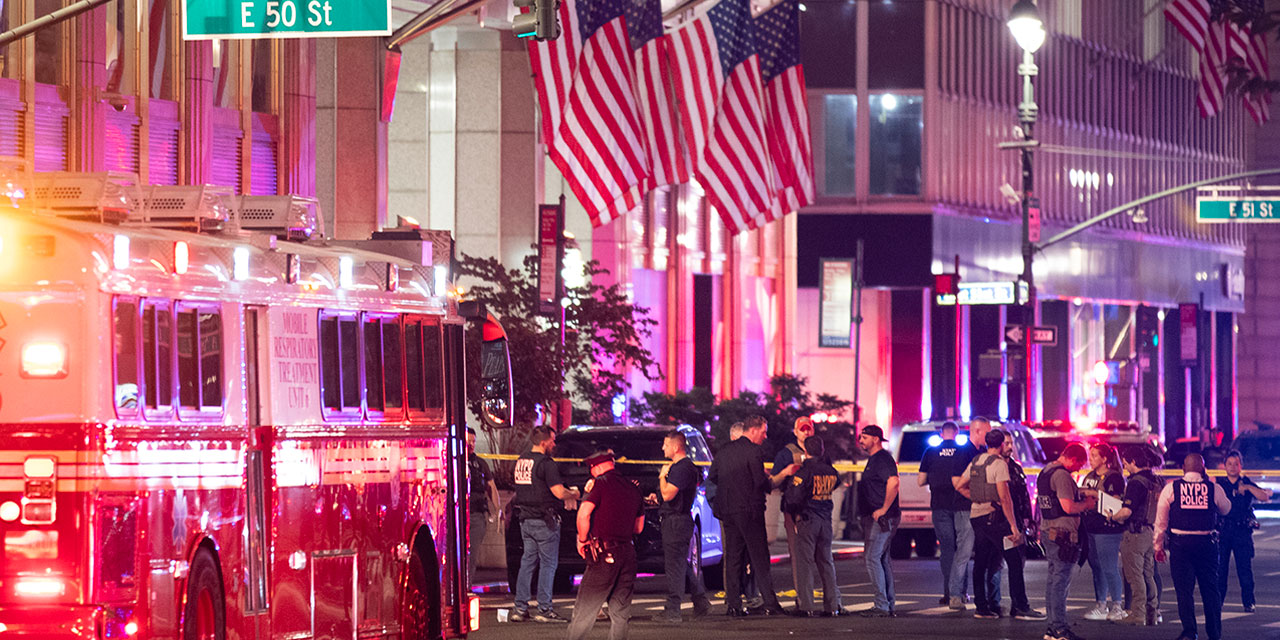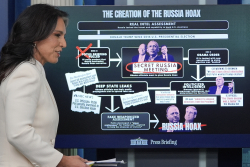
Ismaaiyl Brinsley, Frank James, Luigi Mangione, and now, Shane Tamura. New York City remains a prime target for violent actors whose behavior is among the hardest for city government to detect and prevent: the lone attacker, often driven by a mix of ideological motive and, in some cases, mental illness, who arrives suddenly from out of state to carry out a high-profile assault. By nature, New York cannot anticipate or intercept every ambush by individuals with no prior ties to the city. But there is more it can do—particularly by leveraging license-plate recognition technology—to identify and incapacitate such individuals within hours, if not minutes.
Around 6:30 p.m. Monday, police say, Tamura illegally parked his car near 345 Park Avenue, between 51st and 52nd Street, walked into the lobby of the building with an AR-15-style rifle, and began shooting. He shot and killed an NYPD officer, Didarul Islam (a father of two young children whose wife is pregnant), and killed a security guard and a civilian—a Blackstone executive and mother of two—who worked in the building, before heading via elevator to the 33rd floor, where he shot and killed a fourth civilian before fatally shooting himself. Among the wounded, a fifth person suffered a critical injury.
Finally, a reason to check your email.
Sign up for our free newsletter today.
Tamura, 27, had no apparent ties to New York City; he drove from Nevada, where he lived, to carry out the attack. There’s no evidence that he had ever been arrested in New York, and while he reportedly had a history of mental illness, this record was compiled in Las Vegas, not locally. Tamura’s motive in coming to New York appears to have been to target the National Football League, headquartered at 345 Park, perhaps over his own failed football career and related brain injury. (The last news article mentioning Tamura’s name before Monday’s attack was a story from 2014, when Tamura would have been 16, about a high school football game in which he had played).
New York City has seen this kind of threat before—and recently. Luigi Mangione, also 27, had no prior connection to the city before arriving by bus last December. He stayed in a hostel before allegedly murdering UnitedHealthcare CEO Brian Thompson outside the Midtown Hilton, just a 13-minute walk from 345 Park Avenue. Mangione’s motive, like Tamura’s apparent one, was to target a national institution, both to make an ideological point—the imputed evils of health-insurance administration and professional football, respectively—and to avenge a personal injury (in Mangione’s case, supposedly debilitating back pain).
In carrying out a mass shooting rather than a targeted assassination, Tamura also resembles Frank James, who shot and wounded ten people on a Brooklyn subway in April 2022. James, then 62, had no recent connection with New York, though he did have a decades-old criminal history here. To carry out his attack, he drove a rented van from Philadelphia, where he had lived. James (now serving a life sentence) had ranted online about supposed racial injustices, but he also endured schizophrenia-related paranoia for much of his adult life, and posted menacingly on social media.
Before Frank James, there was Ismaaiyl Brinsley, who, in 2014, drove from Maryland to Brooklyn to murder two police officers, Rafael Ramos and Wenjian Liu, in their patrol car before taking his own life. Brinsley, 28, hated the police; he had a long petty criminal record elsewhere, but no adult connection with New York.
That New York is regularly targeted by people with no recent history here, but who are drawn by the city’s global profile, including its agglomeration of corporate interests and its emblematic subway system, is a challenge for police and prosecutors. New York’s normal practice of preventing violent crimes relies in large part on intercepting lower-level criminals before they escalate to higher crimes. The NYPD, for instance, has removed 3,086 guns from streets and subways this year, many by stopping and searching people breaking other laws, thereby preventing shootings. The city can also hospitalize people whose mental illness poses a danger to themselves and others.
Indeed, a recent revival of these tactics, after years of pullbacks, has helped propel New York to a record-low murder and shooting level this year (though other crimes remain higher than pre-2020 levels). The city uses these tools imperfectly, even when things are going well, but it can’t apply them very effectively to people who just got here days or even hours ago, and who have come with the sole purpose of committing a planned attack. That doesn’t mean that the city shouldn’t try; it would be worthwhile to know if Tamura, unfamiliar with New York driving, committed any traffic infractions as he drove to Park Avenue that might have merited a police stop.
In the near quarter-century since 9/11, New York has honed strategies and tactics to prevent organized terror attacks. These techniques are more effective against people who are conspiring together, and thus leaving a trail of some kind, than against single assailants.
New York isn’t helpless, though. Aided by large-scale data mining, the city can track public social media, scanning for posters who regularly make threatening comments that target New York City or people and firms located here.
New York could also make better use of its network of license-plate cameras, now affixed to every police vehicle and employed as well by independent agencies such as the Metropolitan Transportation Authority and Port Authority. For now, the NYPD largely uses cameras to identify stolen cars, cars used in crimes, and cars with fake plates. Gaps persist: cameras didn’t catch the driver of a stolen car before she allegedly hit and killed two people in Manhattan earlier this month. The creation of a national network, in cooperation with other states and cities, could provide data, for instance, on vehicles whose registered owner is wanted for arrest in another jurisdiction; police could then stop the vehicle just after it has entered the city via bridge or tunnel. Such a network wouldn’t catch everyone, but it would catch some, and likely improve traffic safety, too.
As New York elects a new mayor this fall, it cannot ignore the reality that within less than nine months, it has suffered two targeted attacks on specific midtown targets, which have taken five lives between them. These aren’t aberrations, and corporate New York won’t consider them such: brace for more office buildings and hotels that resemble fortresses, with employees and visitors required to scan their passes outside the building premises to gain entrance. (Before 9/11, anyone could walk into almost any office building unchallenged.)
A successful city also can’t be a bunker. To regain and keep at least some confidence on the part of local corporations and other high-profile targets, New York will need a mayor cognizant of executives’ and workers’ heightened fears but also experienced and competent enough to execute a plan. Nothing was particularly wrong with the two statements that the mayoral frontrunner, 33-year-old Assemblyman Zohran Mamdani, released after Monday’s attack—he offered condolences to the victims, gratitude to first responders, and a tribute to NYPD officer Islam. But voters must reconcile these statements with Mamdani’s once calling the NYPD “wicked and corrupt” and describing capitalism itself as a crime.
If New Yorkers decide that Mamdani isn’t the answer in November, their main alternative choices are the current mayor, Eric Adams, whose NYPD is finally in the hands of a capable commissioner, Jessica Tisch, but who previously let the department command become infected with alleged corruption and other wrongdoing; and Andrew Cuomo, the former governor who recently lost to Mamdani in the Democratic primary. For now, Adams and Cuomo are just consuming each other’s votes. That leaves New Yorkers hoping that Mamdani would learn quickly on the job—gaining, in addition to basic management skills, a new philosophy that’s more accommodating of capitalists and police, both in peril.
Photo by Liao Pan/China News Service/VCG via Getty Images
Source link

















